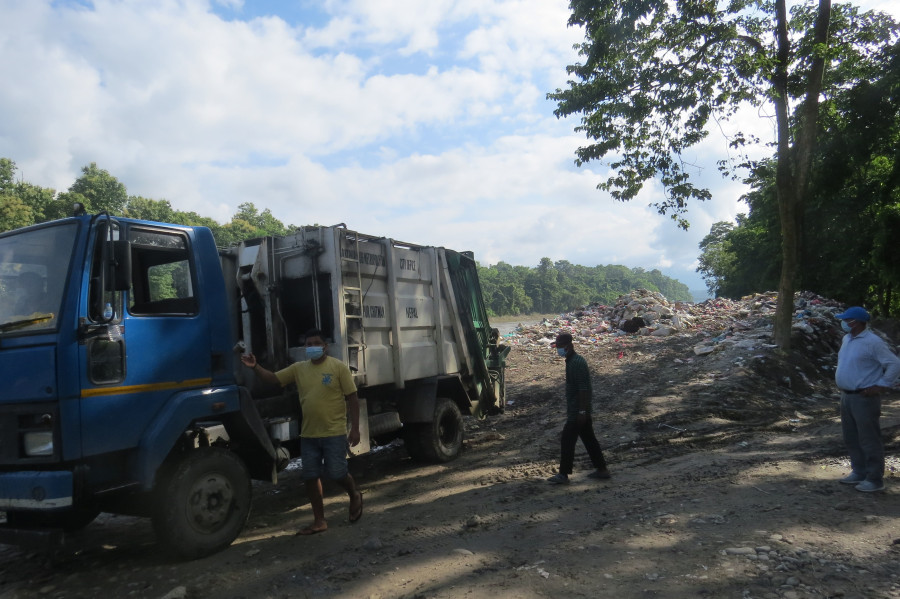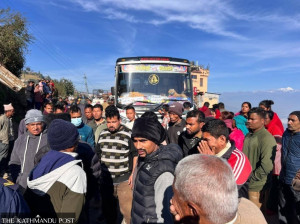Bagmati Province
Bharatpur dumps waste in Narayani River banks despite having designated land to build a landfill site
Monsoon spells disaster for locals living in riverbank settlements with garbage washed ashore by the overflowing river.
Ramesh Kumar Paudel
Krishna Bahadur Pariyar, a resident of Nagarban—a settlement of 74 families by the Narayani River in Narayangadh, says monsoon brings anxiety into his life.
On top of fears about the possible inundation of his home by the river, he says he also has to worry about garbage from the nearby landfill site overflowing into his settlement.
“During the dry season, garbage trucks dump waste in areas that are at least a kilometre away from human settlements,” Pariyar said. “But during the monsoon, the trucks dispose of waste right by the settlements, as rains make it difficult for garbage trucks to traverse the dirt track that leads to the dumping site, and the overflowing river turns the garbage into mulch.”
Every monsoon, Bharatpur Metropolitan City disposes of its waste on the banks of the river, which is just 400 metres from the Nagarban settlement, making life difficult for all local residents.
Waste management in Bharatpur Metropolitan City has become a major problem, especially for people living near the banks of Narayani River, as the riverside is the only landfill site for the city of around 300,000 people. The population of the metropolis stood at 199,867, according to 2011 census.
The city has been dumping its garbage on the banks of Narayani River for the past 15 years after the then Hetauda Appellate Court issued an order banning the disposal of waste at Jaldevi Community Forest, stating its biological importance.
Since then, Bharatpur has been dumping its waste under the Narayani River bridge, which is just 200-300 metres away from the city area.
The federal government in the fiscal year 2011-12 had allotted 15 bighas of land in the Jaldevi Community Forest to the metropolitan city to build a well-managed landfill site. However, no work has been done to that effect and the city has yet to construct a landfill site.
As compensation for the use of the forestland, the metropolis some five years ago had purchased another 15 bighas of land in Madi to be used for reforestation.
Officials at the Bharatpur Metropolitan City Office say that the metropolis has been using the Narayani River banks to dispose of the city’s garbage for a lack of an alternative. The office, however, claims to be mindful of the settlements near the riverbanks.
“The city generates 70-80 tonnes of garbage on a daily basis. The metropolis’ pickup trucks go from door-to-door collecting waste. For the service, the city charges a certain fee from its residents,” said Birat Ghimire, chief engineer at the Bharatpur Metropolitan City Environment Division.
“We take extra precautions to leave the settlements unpolluted while dumping waste in the riverbanks. But the locals living in the area are always protesting.”
According to Yogendra Poudel, chairman of the Sansari Mai Toll Reform Committee, a local community group in Nagarban, the metropolis has been dumping its waste at the river banks instead of burying it. This has led to environmental pollution in the riverbanks and the settlements nearby.
“Although the metropolis is supposed to bury its garbage, they hardly do it on time,” said Poudel. “The whole area stinks of garbage and the waste also enters the marketplace.”
Poor waste management at the banks of the Narayani River has not only affected the people living nearby but has also impacted the ecology of the surrounding areas due to the hazardous toxic gas released from the dumping site.
“Vegetation in one-and-a-half bighas of land in the Sansari Mai area along the river bank were cut off while burying the city’s waste,” said Poudel. “As the metropolis’ poor handling of waste has been adversely affecting the surrounding vegetation, we had notified the forest office regarding the matter, but no one has addressed the issue as of date.”
The metropolitan office in 2018 had signed an agreement with the Sudokwon Landfill Site Management Corporation of South Korea to come up with a masterplan for a proper waste management system. The masterplan was to be prepared within 15 months from the date of the agreement.
The consultant company hired by the Korean company had failed to conduct a field study of the landfill site during the monsoon season, so they had to wait for this year’s monsoon to collect the data, according to Ghimire.
“Once the rain stops, the ground team would move to clear the landfill site for the study,” Ghimire said. “Seventy percent of the work on the masterplan has been completed. The construction of the landfill site will commence once the masterplan is ready. But until then, we will have to dump the city’s waste at the current location.”
The locals of Nagarban; however, are not satisfied with the metropolis’ approach to waste management and are frustrated that their pleas and protests have gone unheard.
“Around 20-25 garbage trucks pass by my house to dump waste at the river banks every day,” said Pariyar. “It’s getting difficult to get a breath of fresh air around here. We have asked the municipality to move the dumping site away from the settlement but there has been no response from them.”




 16.12°C Kathmandu
16.12°C Kathmandu1.jpg)











